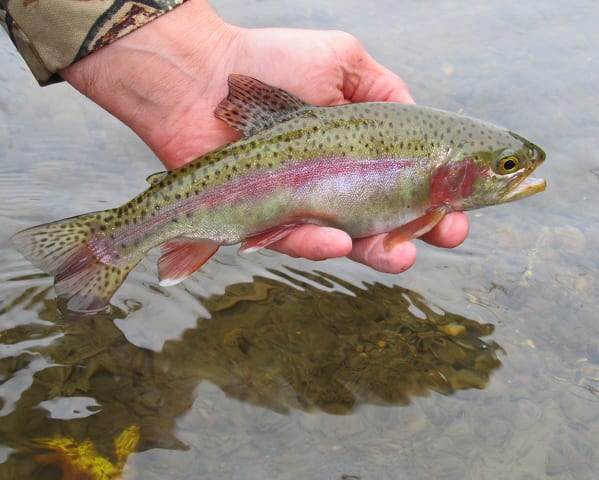Rainbow trout are widely stocked in Pennsylvania because of their fast growth and suitability to hatchery life. However, they are not a native fish to our waters.
Rainbows are members of the salmon family and close relatives to the cutthroat trout and Pacific salmon. Rainbow trout originated west of the Rocky Mountains and they are native to that area of the western United States, Canada and northern Mexico. They have been stocked widely across the U.S. and Canada, as well as in New Zealand, South Africa, Japan and other countries. When trout are sold in stores as food, they are almost always rainbow trout.
The Pennsylvania Fish and Boat Commission plans to stock approximately 2.2 million rainbow trout this year. Most of them have already been distributed. The total number of rainbows stocked is higher than the number of brook and brown trout combined because rainbows are easier to raise.
According to Pennsylvania Fish & Boat Commission records, Oncorhynchus mykiss was first stocked in the Keystone State in 1888. Oddly enough, the receiving stream was the Susquehanna River, which is now considered to be an excellent smallmouth bass fishery, and too warm for trout.
Although rainbow trout cannot be called “native” in Pennsylvania, they can be wild. Documented naturally reproducing strains exist in several streams in the Hemlock Creek drainage in Venango County, in a number of Laurel Highlands’ streams (Somerset and Westmoreland counties), the Falling Spring Branch near Chambersburg, as well as in streams in Cumberland and Wayne counties.
Rumors persist about wild rainbow trout occurring in Spring Creek and it is possible that this happens on a limited basis. It is highly unlikely that a naturally reproducing population of any significance exists in Spring Creek, which is a wild brown trout fishery. While spawning is attempted each year by Spring Creek rainbows, it is more likely that the rainbows living there are the result of escapes from one of the three trout hatcheries within the watershed. Rainbows are stocked in Bald Eagle Creek and can easily swim upstream.
Rainbow trout can be identified by the numerous small black spots that pepper their sides and tails. Browns usually have spotless tails. Wild rainbows often have a beautiful red stripe along their sides; in hatchery-raised fish, this stripe can be red, a pale pink or even absent. The tiny non-haloed black spots are the sure-fired identification tool.
Lake Erie’s rainbows are very silvery, with few spots. They also have a steelgray head and back. This feature gives rise to one of their nicknames, the steelhead. The golden-colored trout, often mistakenly called palominos, are golden rainbows that are stocked by the PFBC. Their unique coloration is the result of a genetic mutation that first appeared in rainbow trout raised in a West Virginia fish hatchery.
Trout, including rainbows, eat a wide variety of aquatic insects, crayfish and minnows. Larger fish tend to select larger food items. Although textbooks describe them as lovers of swift water, stocked rainbows show no such habitat preference in our local streams.
Most rainbow trout are spring spawners, but some strains may spawn during any month. Their eggs are sensitive to extreme cold temperatures and certain kinds of dissolved metals. Rainbows are also the least acid-tolerant of all of the trout found in the Keystone State. These factors may limit the natural reproduction of rainbows in Pennsylvania.
Hatchery rainbows are usually made to spawn in late summer or early fall. The fish are raised for approximately 18 months. They average about 10-and-a-half inches in length when they are stocked in March or early April.
I caught my largest rainbow trout in a Lake Erie tributary, and it measured 23-and-a-half inches and weighed almost six pounds.
That is nothing compared to the all-tackle freshwater record rainbow trout — a 48-pounder caught in Lake Diefenbaker, in Saskatchewan, Canada, on September 5, 2009, by Sean Konrad. Pennsylvania’s state record rainbow was caught by Dennis Clouse of Bethlehem on Jordan Creek in Lehigh County in 1986. It weighed 15 pounds, six ounces. The state record steelhead was caught in Walnut Creek, Erie County, in 2001, by Corey Brown of Osterburg, Bedford County. That trout weighed 20 pounds, three ounces.
A 100 percent pure hatchery product, the state record golden rainbow was 13 lbs., eight oz. It was caught by Eli Borger of Palmerton in Mahoning Creek in Schuylkill County.



